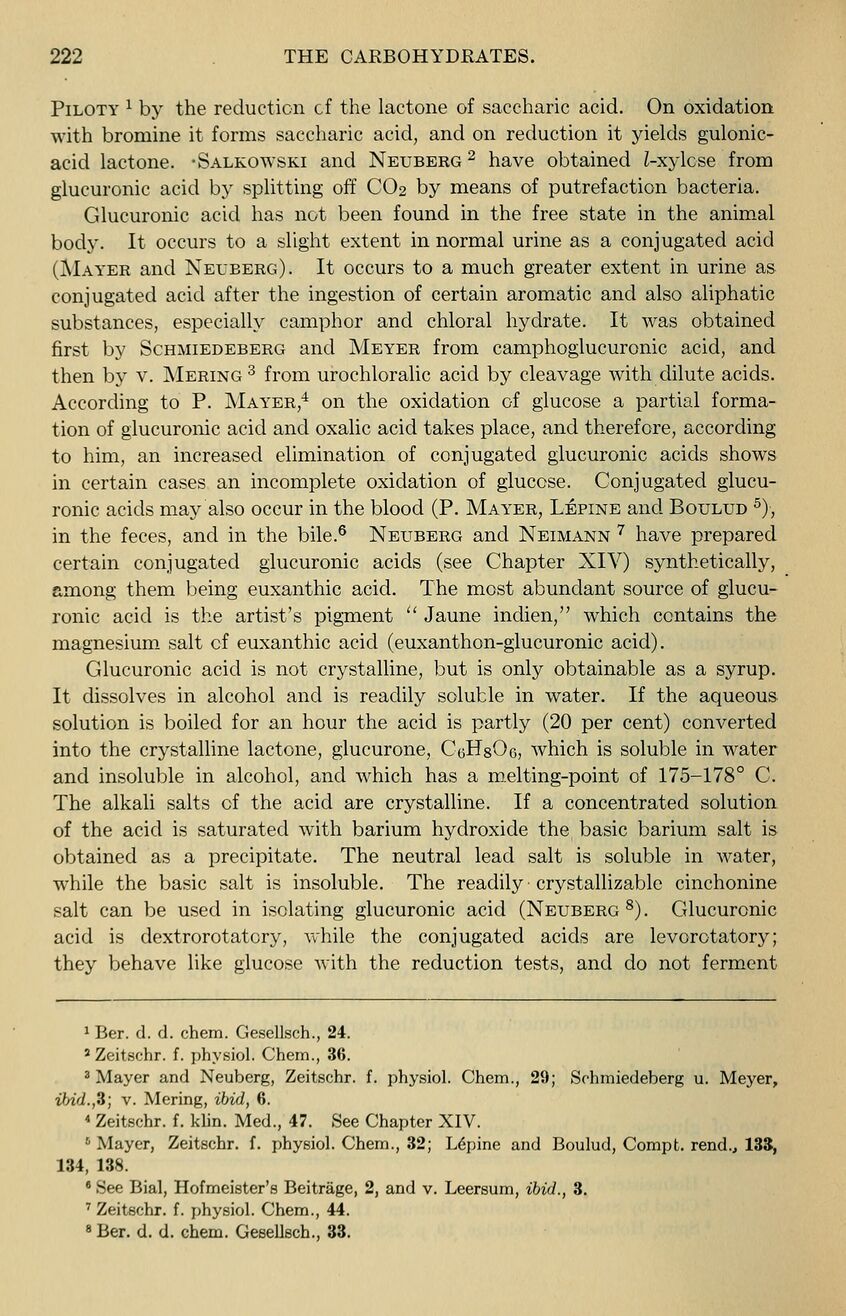
Full resolution (JPEG) - On this page / på denna sida - III. The Carbohydrates - 1. Monosaccharides - Appendix to the Monosaccharides - b. Glucuronic Acids

<< prev. page << föreg. sida << >> nästa sida >> next page >>
Below is the raw OCR text
from the above scanned image.
Do you see an error? Proofread the page now!
Här nedan syns maskintolkade texten från faksimilbilden ovan.
Ser du något fel? Korrekturläs sidan nu!
This page has never been proofread. / Denna sida har aldrig korrekturlästs.
222 THE CARBOHYDRATES.
Piloty l
by the reduction cf the lactone of saccharic acid. On oxidation
with bromine it forms saccharic acid, and on reduction it yields gulonic-
acid lactone. -Salkowski and Neuberg 2
have obtained i-xylcse from
glucuronic acid by splitting off CO2 by means of putrefaction bacteria.
Glucuronic acid has not been found in the free state in the animal
body. It occurs to a slight extent in normal urine as a conjugated acid
(Mayer and Neuberg). It occurs to a much greater extent in urine as
conjugated acid after the ingestion of certain aromatic and also aliphatic
substances, especially camphor and chloral hydrate. It was obtained
first by Schmiedeberg and Meyer from camphoglucuronic acid, and
then by v. Mering 3
from urochloralic acid by cleavage with dilute acids.
According to P. Mayer,4
on the oxidation of glucose a partial forma-
tion of glucuronic acid and oxalic acid takes place, and therefore, according
to him, an increased elimination of conjugated glucuronic acids shows
in certain cases an incomplete oxidation of glucose. Conjugated glucu-
ronic acids may also occur in the blood (P. Mayer, Lepine and Boulud 5
),
in the feces, and in the bile. 6 Neuberg and Neumann 7 have prepared
certain conjugated glucuronic acids (see Chapter XIV) synthetically,
among them being euxanthic acid. The most abundant source of glucu-
ronic acid is the artist’s pigment " Jaune indien," which contains the
magnesium salt cf euxanthic acid (euxanthon-glucuronic acid).
Glucuronic acid is not crystalline, but is only obtainable as a syrup.
It dissolves in alcohol and is readily soluble in water. If the aqueous
solution is boiled for an hour the acid is partly (20 per cent) converted
into the crystalline lactone, glucurone, CaHsOo, which is soluble in water
and insoluble in alcohol, and which has a melting-point of 175-178° C.
The alkali salts of the acid are crystalline. If a concentrated solution
of the acid is saturated with barium hydroxide the basic barium salt is
obtained as a precipitate. The neutral lead salt is soluble in water,
while the basic salt is insoluble. The readily crystallizable cinchonine
salt can be used in isolating glucuronic acid (Neuberg 8
). Glucuronic
acid is dextrorotatory, while the conjugated acids are levorotatory;
they behave like glucose with the reduction tests, and do not ferment
1
Ber. d. d. chem. Gesellsch., 24.
J
Zeitschr. f. physiol. Chem., 36.
3
Mayer and Neuberg, Zeitschr. f. physiol. Chem., 29; Schmiedeberg u. Meyer,
ibid. ,3; v. Mering, ibid, 6.
* Zeitschr. f. klin. Med., 47. See Chapter XIV.
5
Mayer, Zeitschr. f. physiol. Chem., 32; Lepine and Boulud, Compt. rend.., 133,
134, 138.
8
See Bial, Hofmeister’s Beitrage, 2, and v. Leersum, ibid., 3.
7
Zeitschr. f. physiol. Chem., 44.
8
Ber. d. d. chem. Gesellsch., 33.
<< prev. page << föreg. sida << >> nästa sida >> next page >>